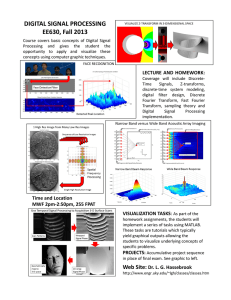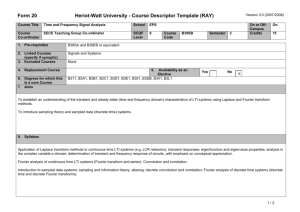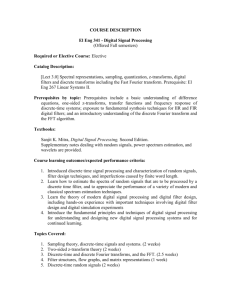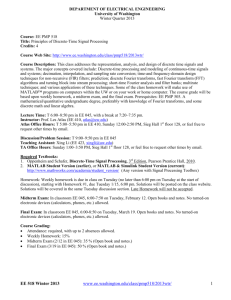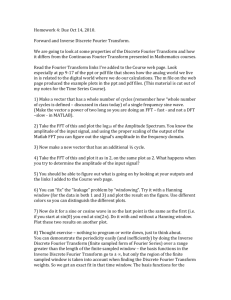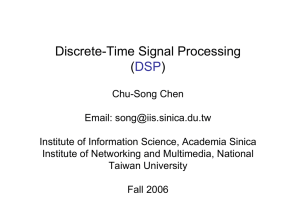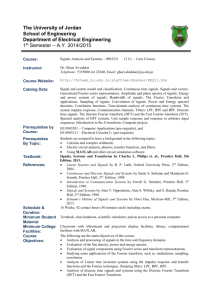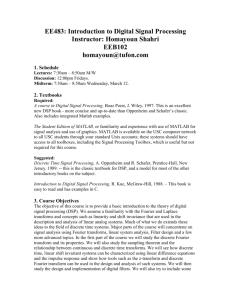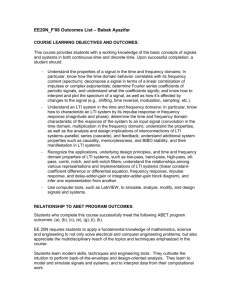EE361 - Signals and Systems II - Department of Electrical and
advertisement
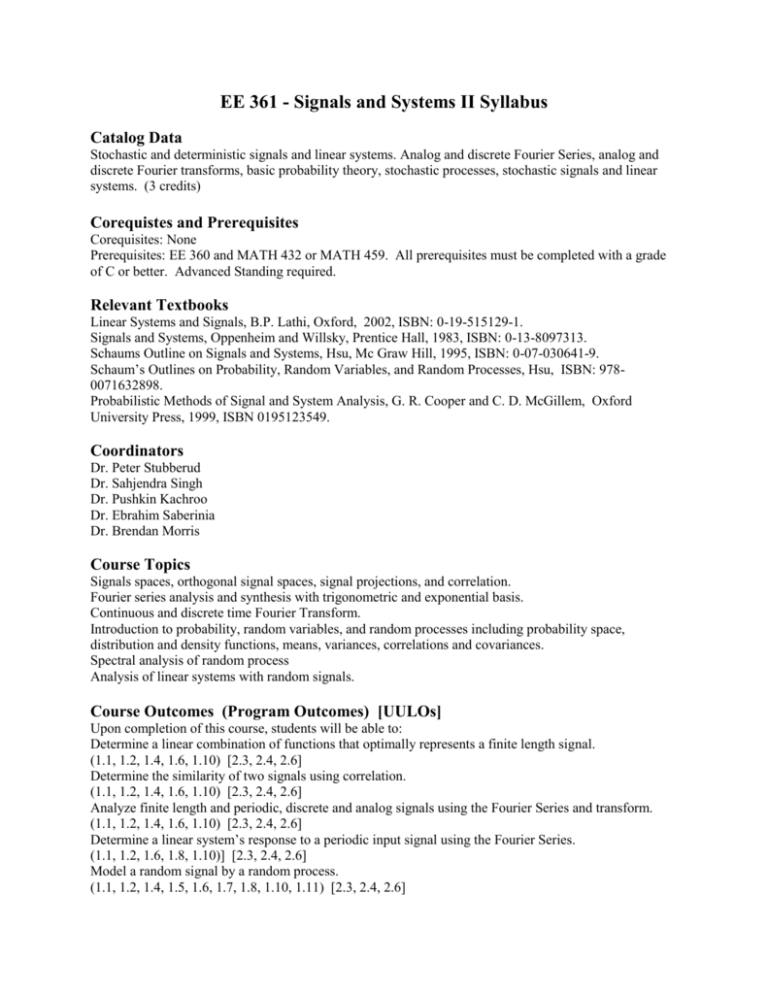
EE 361 - Signals and Systems II Syllabus Catalog Data Stochastic and deterministic signals and linear systems. Analog and discrete Fourier Series, analog and discrete Fourier transforms, basic probability theory, stochastic processes, stochastic signals and linear systems. (3 credits) Corequistes and Prerequisites Corequisites: None Prerequisites: EE 360 and MATH 432 or MATH 459. All prerequisites must be completed with a grade of C or better. Advanced Standing required. Relevant Textbooks Linear Systems and Signals, B.P. Lathi, Oxford, 2002, ISBN: 0-19-515129-1. Signals and Systems, Oppenheim and Willsky, Prentice Hall, 1983, ISBN: 0-13-8097313. Schaums Outline on Signals and Systems, Hsu, Mc Graw Hill, 1995, ISBN: 0-07-030641-9. Schaum’s Outlines on Probability, Random Variables, and Random Processes, Hsu, ISBN: 9780071632898. Probabilistic Methods of Signal and System Analysis, G. R. Cooper and C. D. McGillem, Oxford University Press, 1999, ISBN 0195123549. Coordinators Dr. Peter Stubberud Dr. Sahjendra Singh Dr. Pushkin Kachroo Dr. Ebrahim Saberinia Dr. Brendan Morris Course Topics Signals spaces, orthogonal signal spaces, signal projections, and correlation. Fourier series analysis and synthesis with trigonometric and exponential basis. Continuous and discrete time Fourier Transform. Introduction to probability, random variables, and random processes including probability space, distribution and density functions, means, variances, correlations and covariances. Spectral analysis of random process Analysis of linear systems with random signals. Course Outcomes (Program Outcomes) [UULOs] Upon completion of this course, students will be able to: Determine a linear combination of functions that optimally represents a finite length signal. (1.1, 1.2, 1.4, 1.6, 1.10) [2.3, 2.4, 2.6] Determine the similarity of two signals using correlation. (1.1, 1.2, 1.4, 1.6, 1.10) [2.3, 2.4, 2.6] Analyze finite length and periodic, discrete and analog signals using the Fourier Series and transform. (1.1, 1.2, 1.4, 1.6, 1.10) [2.3, 2.4, 2.6] Determine a linear system’s response to a periodic input signal using the Fourier Series. (1.1, 1.2, 1.6, 1.8, 1.10)] [2.3, 2.4, 2.6] Model a random signal by a random process. (1.1, 1.2, 1.4, 1.5, 1.6, 1.7, 1.8, 1.10, 1.11) [2.3, 2.4, 2.6] Determine the mean, variance, autocorrelation, cross-correlation, covariance and power spectral density of a random process. (1.1, 1.2, 1.4, 1.5, 1.6, 1.7, 1.8, 1.10, 1.11) [2.3, 2.4, 2.6] Analyze a linear system’s response to a random signal. (1.1, 1.2, 1.4, 1.5, 1.6, 1.7, 1.8, 1.10, 1.11) [2.3, 2.4, 2.6] Program Outcomes Upon graduation, Electrical Engineering students will be able to: Apply the appropriate technical knowledge and skills An ability to apply mathematics through differential and integral calculus, An ability to apply advanced mathematics such as differential equations, linear algebra, complex variables, and discrete mathematics, An ability to apply knowledge of basic sciences, An ability to apply knowledge of computer science, An ability to apply knowledge of probability and statistics, An ability to apply knowledge of engineering, An ability to design a system, component, or process to meet desired needs within realistic constraints, An ability to identify, formulate, and solve engineering problems, An ability to analyze and design complex electrical and electronic devices, An ability to use the techniques, skills, and modern engineering tools necessary for engineering practice, An ability to design and conduct experiments, as well as to analyze and interpret data, University Undergraduate Learning Outcomes (UULOs) Inquiry and Critical Thinking Identify problems, articulate questions or hypotheses, and determine the need for information. Access and collect the needed information from appropriate primary and secondary sources. Use quantitative and qualitative methods, including the ability to recognize assumptions, draw inferences, make deductions, and interpret information to analyze problems in context, and then draw conclusions. Recognize the complexity of problems, and identify different perspectives from which problems and questions can be viewed. Evaluate and report on conclusions, including discussing the basis for and strength of findings, and identify areas where further inquiry is needed. Identify, analyze, and evaluate reasoning, and construct and defend reasonable arguments and explanations. Computer Usage Students write code using a computational programming language (such as Matlab) to create signals and system and analyze linear systems. Instruction of computational programming language and its application to signals and linear systems takes place in EE 360D. Grading Homework Assignments, Computational Software Assignments (min 10% of final grade), Exam, Project, Final Exam. Course Syllabus Preparer and Date Peter Stubberud, Thursday, January 22, 2015
